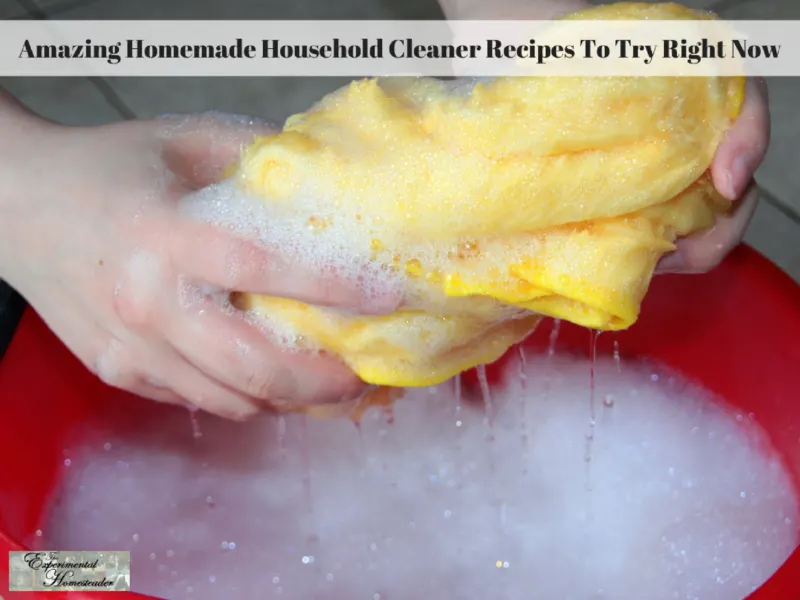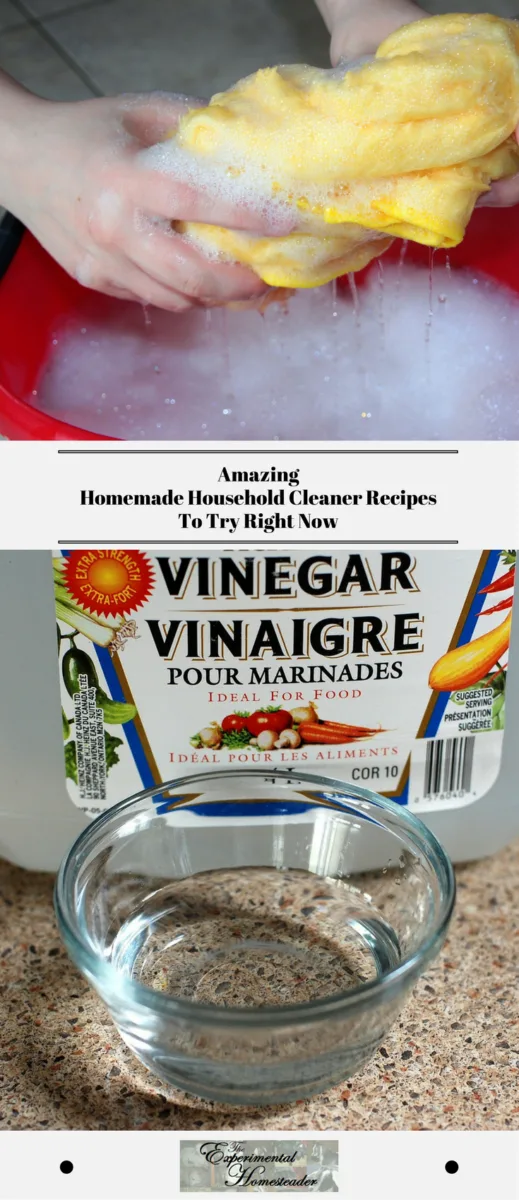There are a number of homemade household cleaner recipes available.
The ones you use really depends on your personal preference.
These homemade cleaners are relatively cheap to make as long as you keep a steady supply of staples such as baking soda and vinegar on hand.
Many of the herbs and spices you can grow.
You need to decide if you are using organic products or conventional products to make your cleaners with.
I personally buy certified organic products because I want to know exactly what is in my household cleaners and do not want to take the chance of them containing chemicals of any kind.
Below are homemade cleaner recipe safety tips and several of my favorite natural household cleaner recipes.
There are also links to products I recommend from companies I have a referral relationship with. I will be compensated if you make a purchase after clicking on my links.
Homemade Cleaner Recipe Safety Tips
As with any cleaning product, even non-toxic green house cleaning products, care must be used.
Use common sense when it comes to mixing and labeling products.
Research home cleaning product recipes before you begin.
Use more than one source when doing your research to make sure the items you want to use are safe to combine.
-
- Do not mix two ingredients together that could cause a chemical reaction, such as bleach and ammonia.
- It is best to mix up just what you will be using at that time.
- The first step is to prepare labels for your containers. Make sure all of the containers are clearly marked with the items used in your product and what the product is for. This will help avoid confusion later on.
- Find a safe location out of the reach of children and pets to mix and store the homemade cleaners even though they are made with natural ingredients. If possible, keep cleaning products behind locked doors. If you have small children, never put them under the sink.
- Do not use an excessive amount of any product when cleaning. Use what you need, seal the bottle and set it aside. Never leave containers filled with water or cleaning products unattended. Children and pets are curious. Accidents happen in a matter of seconds, so if you must stop in the middle of cleaning, set your cleaners up out of the way or close the door so no one can enter.
- When you are done cleaning, properly dispose of any used products such as buckets of soapy water. Remember, even with non-toxic cleaning products, safety comes first!There are so many reasons why you might want to make your own homemade cleaners. They are non-toxic, better for the environment and you can use essential oils or other natural products to add scent.
Here are a few of my favorite natural household cleaner recipes:
Natural Carpet Deodorizer
Choose your favorite herbs such as lavender, rosemary, fennel or mint.
Dry them.
You can also use essential oils such as cinnamon, clove or ylang ylang if you are looking for something more exotic.
Don’t forget to dry citrus peels too.
Once you have your dried herbs, choose pleasing combinations.
For example, try fennel, chocolate mint and orange peel with a few drops of rose essential oil.
Or choose lavender, rosemary, lime peel and a few drops of eucalyptus essential oil.
Now that you know what herbs and peels you want to use in your herbal carpet freshener, you will need to grind about a tablespoon of each one.
Add this to two cups baking soda and two cups cornstarch. Mix well.
Once the dried herbs, citrus peels, cornstarch and baking soda are well mixed, add in one or two drops of essential oils.
Mix well again so the essential oils do not clump together.
Set this aside overnight, or if possible, for several weeks, to allow the scents to combine.
When you are ready to use it, remove all pets and children from the room, sprinkle it on the carpet, let it sit for thirty minutes and vacuum.
That’s all there is to it.
You can make as many custom scents as you want.
These herbal carpet fresheners make great gifts for friends and family too!
Window Cleaner Recipe
Recipe #1
Juice 1 lemon and combine it with 2 cups club soda.
Add in ½ tsp. peppermint essential oil and 1 tsp. corn starch.
Mix all the ingredients together in a small bowl then pour into a plastic spray bottle.
Shake well before using.
Recipe #2
Combine ¼ - ½ teaspoon liquid detergent with 3 tablespoons vinegar and 2 cups water.
Pour this mixture into a spray bottle using a funnel.
Once the ingredients have been added shake the spray bottle up a bit and add 10 drops of the essential oil of your choice.
Shake the bottle up again.
Smell the mixture to see if the scent is strong enough to suit you. If not, add a few more drops, testing as you go, until the smell suits you. You can mix essential oils if you like to create a unique scent.
Use this window cleaner as you would a commercial brand. The soap in this recipe is important. It cuts the wax residue from the commercial brands you might have used in the past.
Lime-Scented Vinegar Fabric Softener/Cleaner
Use 1 cup of this cleaner and fabric softener in your wash water or rinse cycle.
You can add ¼ cup to mop water, add a little to your dish water or even rinse your hair with this.
Here is how to make it. Slice limes (or any other citrus fruit) into ¼ or ½ inch slices.
Fill a glass jar as full as possible with the citrus slices.
Pour plain white vinegar over the top of the citrus slices making sure you completely cover them.
Put a non-metallic lid on the jar and set this in a warm sunny window for 2 to 3 weeks.
Then pour the vinegar into another glass container.
The citrus slices will retain some of the liquid, so dump those into cheesecloth or a strainer of some type so you can squeeze the remaining liquid out.
Once you have removed as much liquid as possible, get rid of the citrus slices. I would not compost them because vinegar has weed killing properties - although you could dump them in an area where there was a problem weed such as poison ivy. Just remember you could damage other plants in the vicinity depending on how much vinegar is left in the citrus slices.
If the scent is not strong enough for you, add more citrus slices and start the process over again or add a few drops of your favorite essential oil.
Re-bottle this liquid and keep in a cool, dark, dry place to use as needed.
Creamy Soft Scrub Cleanser – this is perfect for cleaning bathtubs and sinks.
Vegetable Glycerin - optional
Bowl
Pour one-half cup of baking soda into a bowl.
Add enough liquid detergent to make a texture like frosting.
Scoop the mixture onto a sponge and wash the surface.
This recipe rinses easily and doesn’t leave grit.
You can add 1 teaspoon of vegetable glycerin to the mixture and store it in a sealed glass jar to keep the product moist. Otherwise just make as much as you need at a time.
Eucalyptus-Mint Disinfecting Soap – This soap is great for cleaning dishes, floors, stoves, sinks, and hands.
5 cups grated castile soap
½ cup baking soda
1 tsp. borax
1 tsp. eucalyptus essential oil
6 cups hot peppermint tea, made with 6 tbsp. fresh peppermint or 8-12 tea bags
Place the castile soap in a 3-quart stainless steel saucepan.
Add the tea mixing well.
If you are making the tea with fresh herbs bring the water to a boil, add in the tea bags and simmer for 10 minutes then strain.
Simmer very low for 15 minutes, stirring occasionally.
Add the baking soda, borax, and eucalyptus oil. Stir well to blend all the ingredients.
Store the soap in a plastic jug or squirt bottle.
Shake well before using.
Natural Mold Killers
Tea Tree
Nothing natural works for mold and mildew as well as this tea tree essential oil. Note that the smell of tea tree oil is very strong, but it will dissipate in a few days.
2 teaspoons tea tree essential oil
2 cups water
Combine these ingredients in a spray bottle using a funnel to make sure the water gets into the bottle then add the tea tree oil, shake to blend and spray on problem areas.
Do not rinse.
You can store whatever is left in the bottle. Just make sure to shake it up each time before you use it.
Vinegar Spray
Essential oil
Straight vinegar reportedly kills 82 percent of mold.
Pour some white distilled vinegar straight into a spray bottle, add a few drops of essential oil and spray on the moldy area.
Let it set without rinsing. The smell will dissipate in a few hours.
I highly recommend the following articles:
- Amazing Environmental House Cleaning Tools To Try Right Now
- Give Your Home A True Green Cleaning This Spring
- Spring House Cleaning – A Great Opportunity For Preppers, Homesteaders And Others
- How To Start Cleaning And Organizing Your Kitchen
- How To Live A Greener Life
Use the buttons on the right side to share this article with friends or family who might find it useful. Pin the picture below to your pinboard on Pinterest for future reference.






